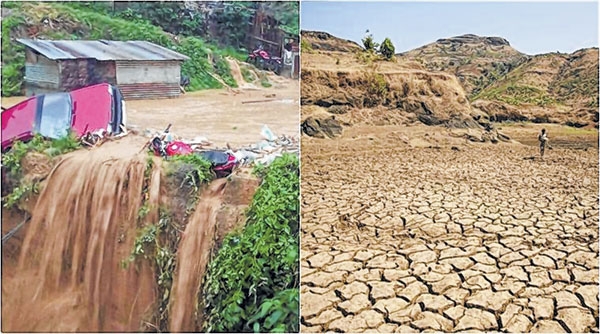Floods and drought

RK Sinha
Talking of drought when some parts of the country are reeling under the fury of floods may look awkward. But it is a reality at the moment. Visuals of flood fury in Assam, North Bihar, parts of Karnataka and Kerala are disturbing. More than 200 people (according to official estimate) have lost their life in floods. North Bihar is facing its worst flood situation in the districts. On the other side, there are reports of deficient rains in large parts of the country. In some areas it is drought like situation.
A family in Buxar district of Bihar doing farming laments that there is little rain.
We are trying to keep paddy saplings green by pumping water in the field and waiting anxiously for rains. But there are hundreds of thousands of marginal farmers who don’t have motor pumps to draw water from bore wells to save their paddy saplings. Even while the saplings are green, it will need sufficient water in the field for its transplantation.
It is not only Buxar but the whole of South Bihar including the state capital Patna and districts of Gaya, Arrah, Jehanabad and Aurangabad have received scant rainfall in the month of June and July. All eyes are now on good monsoon in the month of August and September after which South West Monsoon will start withdrawing from the Indian peninsula.
Till July the deficit in the rainfall in more than 30 districts of Bihar has created a drought like situation in the state. While the state machinery is busy in rescue and relief operations in North Bihar districts affected by floods, officials in Patna are keeping their fingers crossed as to what will happen if monsoon fails in the coming month. Anyone visiting Mumbai will make fun of reports of drought like situation in Maharashtra’s large areas. There was heavy rains last week end in Mumbai throwing traffic and life out of gear. But if you believe reports of weather office 24 out of 36 districts of the state are facing drought like situation. The worst affected regions are Marathwada and Vidarbha where rain deficit ranges from 20% to 50%.
Down south, Tamil Nadu which has been facing worst water crisis in Chennai this year had received deficit rain fall to the extent of 30% in major parts of the state.
In one of my articles written in April this year I had mentioned about erratic behavior of monsoon in India and uneven distribution of rains in the country though the Indian Meteorological Department had declared that this year monsoon will be normal dismissing the El Nino affect in the Pacific Ocean as reported from official agencies in Washington.
I reproduce one paragraph of my article written April 2019 for the benefit of readers. “Few weeks before the official release of Indian Met Department on this year monsoon made on April 15, the department of National Oceanic and Atmospheric Administration of the United States predicted that development of a weak El Niño in the equatorial Pacific Ocean that is expected to continue for a few months at least. “The status of El Niño at this time of the year is usually the first indication of the kind of rainfall that is to be expected during the monsoon season later in the year”.
This is not for the first time that we are witnessing erratic behavior of the monsoon not only in India but world over. Scientists say it is due to climatic change. May be but in a country like ours where two thirds of our population depends on farming and related activities failure of monsoon brings miseries and hardship for them.
According to Prof. Himanshu of Jawaharlal Nehru University, “Long-time observers are in some ways not surprised by the state of Indian agriculture today. In many ways, agriculture has always been in crisis, the intensity of which may have gone up or down from year to year. This time it is serious and has taken political dimensions, with almost all political parties waking up to the situation. The entire rural economy has been affected with consequences for overall economic growth”.
A report prepared by the Food and Agriculture Organisation few years ago says contribution of agriculture to the Indian economy is on the decline since 1950-51.
The report says, “As the Indian economy has diversified and grown, agriculture’s contribution to GDP has steadily declined from 1951 to 2011. While achieving food sufficiency in production, India still accounts for a quarter of the world’s hungry people and home to over 190 million undernourished people. Incidence of poverty is now pegged at nearly 30 percent. As per the Global Nutrition Report (2016), India ranks 114th out of 132 countries on under-5 stunting and 120th out of 130 countries on under-5 wasting and 170th out of 185 countries on prevalence of anemia”.
The government has placed the farm sector on its priority list. Prime Minister Narendra Modi spelt out the government’s emphasis on the farm sector.
At a meeting of NitiAyog in June 2019 Prime Minister stressed upon the need for structural reforms in agriculture which would boost private investment, strengthen logistics and provide ample market support to farmers.
Modi said that the food processing sector should grow at a faster pace to benefit the farmers. He also called for effective steps to tackle the drought situation facing the country with the spirit of ‘per drop more crop.’
The writer is a Member of Rajya Sabha